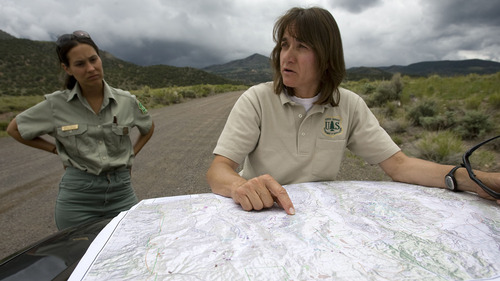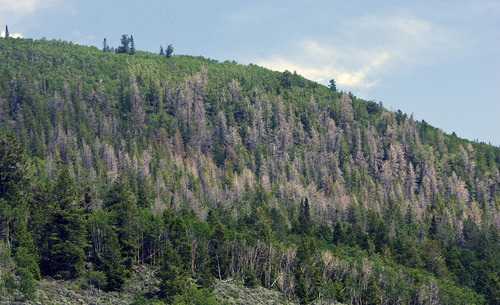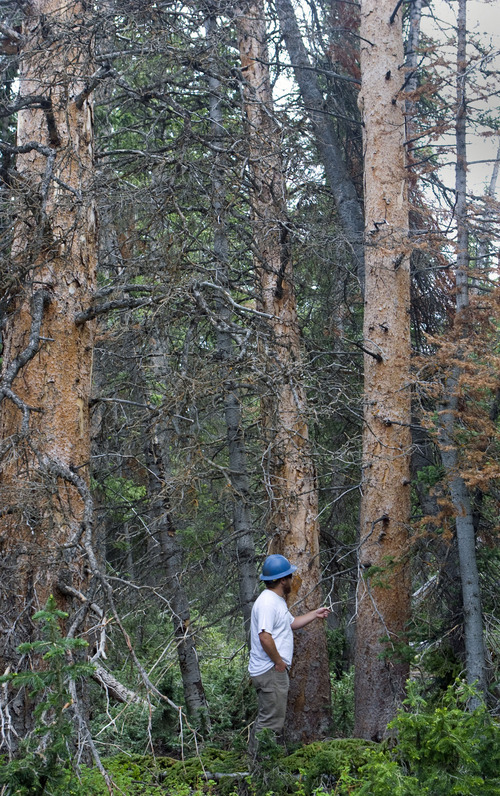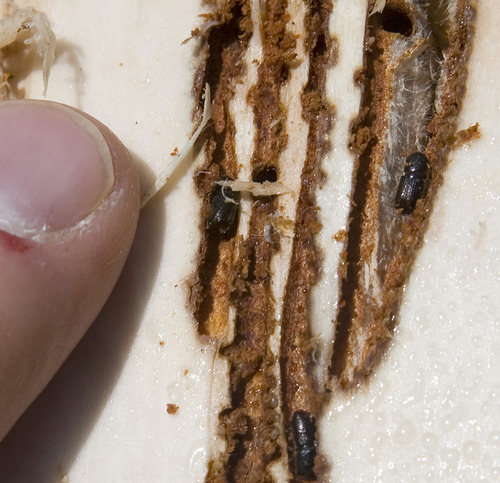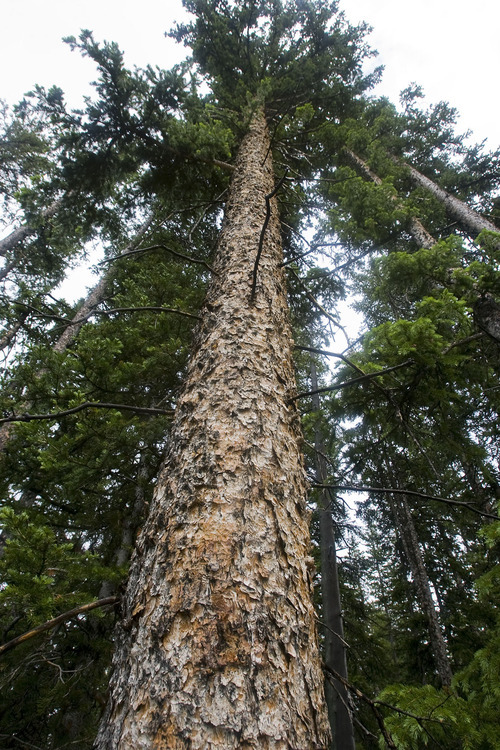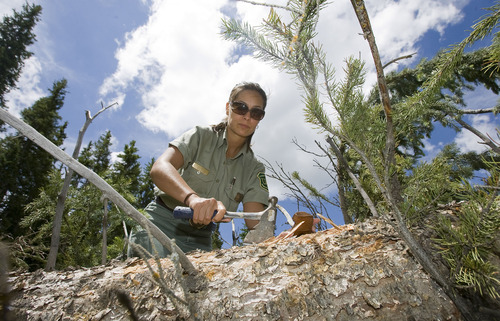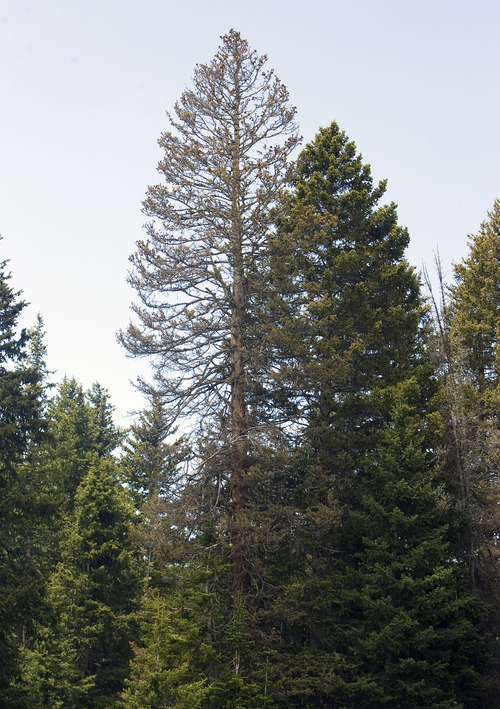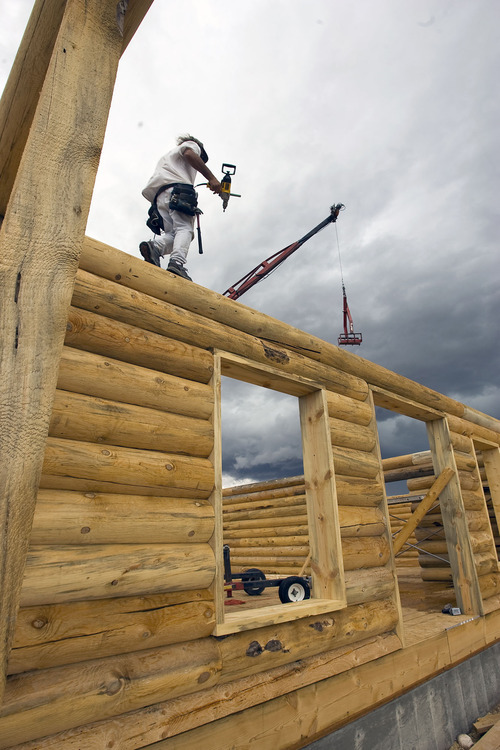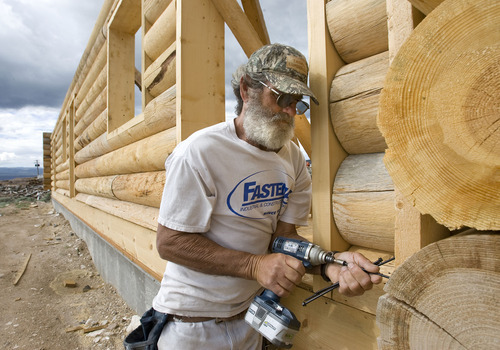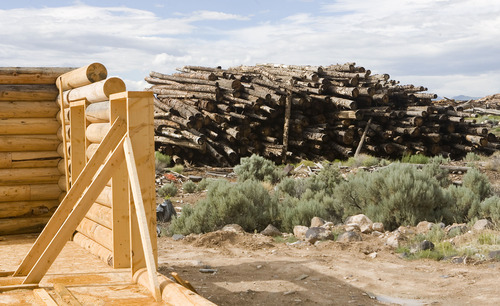This is an archived article that was published on sltrib.com in 2011, and information in the article may be outdated. It is provided only for personal research purposes and may not be reprinted.
Fish Lake • Some three-toed woodpecker in these woods is pleasantly plump on beetles, but the buffet can't go on forever. It lasts only as long as the trees.
The gluttony is written on and around a stocky spruce that looks green and mostly healthy to the untrained eye, except for the fact that it's pecked nude from the waist down.
No bird harmed the tree, though. The damage was already done.
"These trees are loaded with bugs," said Liz Hebertson, a U.S. Forest Service entomologist, down from Ogden to survey this year's spruce-beetle infestation in south-central Utah. Peeling back a neighboring spruce's bark confirms that larvae are maturing, readying for the short flight of their lives in search of new pine prey.
It's nothing new to her. Mountains of Utah's verdant spruce slopes are gone. If climate scientists are right, they might never be back.
After a rain, Utah's high spruce forests evoke the misty Pacific Northwest — unlikely lush islands rising from redrock desert and olive chaparral. Now a complex set of threats conspires to take them down.
One is natural — the beetle with a taste for older trees, aided by a decade of tree-stressing drought. Another is a century of fire suppression that built up fuels to the bursting point. Aiding both those killers is a rising thermometer.
Even if a warmer climate can again support Engelmann spruce — the state's dominant commercial-grade tree — it will be 200 years or more until they grow back to the towering sentinels that 20th-century Utahns knew. In the meantime, subalpine firs may spring up in their place, replacing green for green but not with dollars. Subalpine firs are more brittle — not lumber material.
A lot of people won't take Hebertson's advice and break out the chain saws when spruce needles are still green and inviting. But this woodpecker tree, and every tree around it, will be red by next summer.
"They're dead," said Fishlake National Forest district silviculturist Terry Holsclaw, "but they just don't know it yet."
This alpine grove, above a flowery meadow at nearly 11,000 feet, is Holsclaw's battleground. Unsure of a climate connection beyond a basic drought, he blames time-consuming battles with environmentalists and restrictions on road building for the spruces' plight. He wants to sell trees faster than beetles can swarm them, thinking of it as a mechanic might an oil change.
Saving some spruce for later is an investment that will pay off if the nation sees another building boom, he said. "That's when you'll want this inventory."
His attitude strikes some as a return to the glory days of the 1980s, when forests around here supplied support timber to coal mines at a dizzying pace and when many distrusted a federal agency they considered recklessly industrialist.
It isn't that way now, Holsclaw said.
Getting chain saws into the forest gives the survivors a greater share of the mountain's water and sunlight, and a fighting chance to create a sticky sap to push out invading bugs.
Here at a proposed 1,300-acre logging site called Teeples, Holsclaw hopes to head off a beetle wave that's been spreading from the east for several years.
"My philosophy is, if you can save it, try to save it," he said. "And if it's dead, capture the value."
It's been a losing battle so far, and science suggests it's a long-run lost cause.
First, there's the insect's physiology and its response to increasing warmth. The cold-blooded spruce beetles in these hills once took two years to mature from the egg and fly on to breed in new trees. In the early 2000s, Hebertson said, forest scientists documented a switch to one-year cycles here, which boosted the population and primed a disaster.
Beetles have taken 2 million acres of Utah forest in roughly that time, the largest share of it spruce. The outbreak started in the 1990s around Cedar Breaks National Monument in southwestern Utah, where Hebertson has seen no evidence of spruce regeneration since.
The Forest Service has found that higher temperatures aid and speed beetle production. The Utah Climate Center at Utah State University finds that since 1970 the mercury has risen swiftly when it counts most — more than 3 degrees on average during bug-killing winter lows at a monitoring station at Capitol Reef National Park in southern-central Utah.
A decade of beetles-gone-wild might not spell doom in normal conditions. Big outbreaks have shown up before, and the spruce have rebounded. This time, though, computer models based on society's carbon emissions aren't looking good. They show Engelmann spruce practically blinking out in Utah by 2090, limited to a strand in the High Uintas.
Most of Utah's high-country spruce, plus the firs that associate with them, are in trouble — even under conservative carbon-emission models plotted by Idaho-based scientists at the Forest Service's Rocky Mountain Research Station.
At Brighton, for instance, the mean annual temperature on its spruce-lined slopes is expected to rise by century's end above the 1961-90 "current" norm by a whopping 5½ degrees Celsius.
Such a jump, according to Forest Service projections, would more than double the mountains' growing season to 140 frost-free days, closing in on what exists today thousands of feet downslope in Salt Lake City. It's not spruce country, and, if this scenario plays out, neither would be most of Utah's mountains.
"The future certainly doesn't look good for these alpine species," said Jerry Rehfeldt, a retired plant geneticist who worked on the tree-habitat projections at a lab in Moscow, Idaho. "I think we can say, positively, Engelmann spruce will have a much smaller role in Utah than it does today."
Gradually, Rehfeldt said, dryland species would move uphill while desertification takes hold in the foothills. Utah would look more like northern Nevada.
"The big winner throughout the Great Basin," Rehfeldt said, "is desert scrub."
Something besides climate helped build today's massive beetle outbreaks.
Andrea Brunelle, a University of Utah paleoecologist, studies lake sediments with pollen deposits to determine when trees thrived and when they died.
Utah pioneers made their mark on the forest, she said, and it's showing now. Starting in the 1850s, they axed trees. In places such as the Markagunt Plateau east of Cedar City, they logged the land bare. The homogenous forest that grew back is filled with a single generation of trees uniformly susceptible to drought and other stresses.
"The magnitude of these outbreaks," Brunelle said, "might be different just because of the historic land-management practices."
For those trying to prune the forest and strengthen what remains, administrative headaches persist. One, in Fishlake National Forest, is a Clinton-era rule that prevents building roads into wild areas. Most of the forest's spruce grow in the roadless high country, Holsclaw said.
"It's more the roadless area than anything else that's the problem child," the forester said. It makes intentional fires the only practical management tool, and those are too dangerous on thick spruce slopes, he said.
Republicans in Congress are trying to overturn the roadless rule, but they face stiff opposition. The Theodore Roosevelt Conservation Partnership, a coalition of hunters, blasted the GOP proposal this summer.
Elk and deer need roadless areas, said Joel Webster, the group's Montana-based Western lands director. Without such havens, hunters could deplete the herds.
"If you have too many roads," he said, "critters can't find refuge."
The Forest Service has enough trouble maintaining its existing 370,000 miles of road and has its hands full with forest-restoration work in accessible areas, said Harris Sherman, the U.S. Agriculture Department's undersecretary for natural resources and the environment.
"I don't believe [the roadless rule] complicates this issue to a big extent," Sherman said.
Some environmentalists don't trust the motives for thinning anyway. The Utah Environmental Congress may appeal the planned Teeples timber sale, arguing it's a commercial venture in the guise of forest restoration.
The beetles are nature's way of cleaning house and may boost forest health by giving declining aspens an opening for growth, said Kevin Mueller, the Salt Lake City group's program executive director.
Even if it's right to impede the beetles, Mueller said, no amount of logging could do it.
"It is pretty much equivalent to cloud seeding to stop a hurricane that's already going. It's not going to stop. If the objective is to supply timber for unmet demand, that's something else. I don't support that, but that's a more valid justification," he said.
Trouble is, there isn't much demand. Where a dozen sawmills once stood along the nearby Fremont River Valley, now there's one. The bottom fell out in the 1990s, when Utah coal mines reacted to high timber prices by shifting to steel or other supports. With a goal of logging about 3 million board feet a year, Fishlake's timber program is a third of its former self.
Thousand Lake Lumber, northwest of Bicknell, became the sole survivor by switching to log-home construction. With the housing crash, it has had to diversify, adding fuel pellets and a now-rising lodge and tourist cabins to its portfolio. Owner Bruce Chappell said the U.S. government is helping his business by selling trees affected by the beetles, but he doubts that will revive other mills.
It's a problem for government agents who need industry partners to battle the beetles. Practically no one in the region does this work anymore. According to a 2007 census survey, only 114 Utahns worked at 16 sawmills.
Fishlake timber that once fetched the government $34 per thousand board feet now goes for $10 to $20. If it goes.
If foresters can't thwart this outbreak, Hebertson believes they soon will start hearing about it from urban Utah. That's because the outbreak is fast heading for the Salt Lake Valley, where it could devastate the Cottonwood canyons.
Beetles now chewing through American Fork Canyon may run out of food there and fly on to Albion Basin, a beloved wildflower day trip. There aren't a lot of young spruce there to replace the ancients, Hebertson said. People will "freak out," but the forests will be different.
"Maybe we just have to get used to our ecosystems changing."
Still, preserving spruce where millions expect to see them is worth a shot. On her advice, the Uinta-Wasatch-Cache National Forest is gathering Cottonwood Canyon seeds. After all, the spruce aren't going to replant themselves.
bloomis@sltrib.com Danielle Reboletti, below, an entomologist for the U.S. Forest Service, searches for spruce beetles on a downed Engelmann spruce in Fishlake National Forest. By selling trees killed by the beetles, the government is helping Thousand Lake Lumber, a company northwest of Bicknell that specializes in log-home construction, fuel pellets and lodge and tourist cabins. At left, carpenter Duane Platt works on a log home in Lyman.



